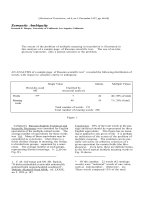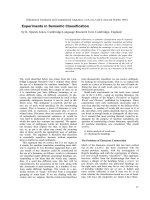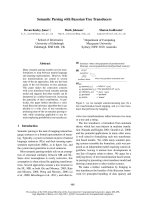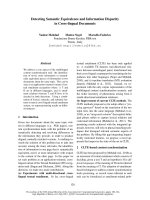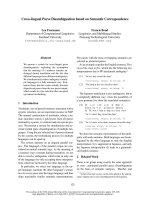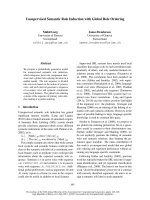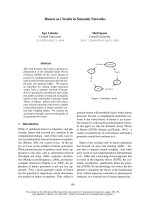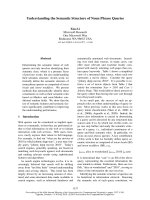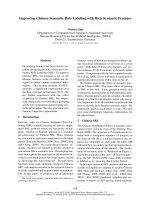Tài liệu Báo cáo khoa học: " Semantic Ambiguity" pdf
Bạn đang xem bản rút gọn của tài liệu. Xem và tải ngay bản đầy đủ của tài liệu tại đây (112.89 KB, 2 trang )
[
Mechanical Translation
, vol.4, no.3, December 1957; pp. 68-69]
Semantic Ambiguity
Kenneth E. Harper, University of California, Los Angeles, California
The extent of the problem of multiple meaning in translation is illustrated in
this analysis of a sample page of Russian scientific text. The use of an idio-
glossary represents only a partial solution to the problem.
AN ANALYSIS of a sample page of Russian scientific text
1
revealed the following distribution of
words, with respect to semantic clarity or ambiguity:
Single Value
Idioms
Multiple Values
Word-for-word
Clarified by
MT
structural analysis
Words
77*
7
24
46 ( 30% of total)
Running
40
24
75 (
28% of total
)
words
Total
number of words: 151
Total
number of running words: 266
Figure 1
Callaham's Russian-English Technical and
Scientific Dictionary was consulted for English
equivalents of the multiple-valued words. The
average number of equivalents for these words
was 8.6. Many of these equivalents may be
considered as synonyms; when there is a
fairly distinct change in meaning, the listing
is divided into groups, separated by a semi-
colon. The average number of such groups,
representing distinct meanings, is 3. 0 (see
Fig. II).
Conclusion: 30% of the total words in the pas-
sage analyzed should be represented by three
English equivalents. This figure has no mean-
ing as applied to any given word; it is perhaps
an indication of the extent of the problem of
multiple meaning. The problem can be par-
tially solved by an arbitrary selection of a
given equivalent for certain fields (the Idio-
glossary). Even here, there are definite limits,
as the list of typical multiple meaning words in
Fig. II shows.
1. F. M. Gol'tsman and SH. SH. Raskin,
"O dielectricheskikh svoistvakh nekotorykh
polimorfnykh organicheskikh soedinenii",
Doklady Akademii Nauk SSSR, vol. LXXIX,
no. 5. 1953. p. 187.
* Of this number, 22 words (42 runnings
words) were "technical" words of one value,
such as 'polymorphic', 'dielectric', etc.
These words composed 15% of the total.
Semantic Ambiguity 69
Multiple listings of equivalents, taken from Callaham's Technical Dictionary, are illustrated by
the following sample entries. (The figures indicate, left, the total number of equivalents, and
right, the lexicographer's attempt to distinguish between groups of synonyms.)
9-3
изменение
:
change, alteration, variation, modifica-
tion, conversion, transformation; fluc-
tuation, deviation; correction
9-2
объем
:
volume, size, bulk, space, capacity,
contents; compass, extent, amplitude
11-4 переход:
transition, passing over, passing, con-
version; passage, crossing, migration
(of ions); exchange (of places), switch-
ing; blending, shading (of colors)
15-6 величина:
size, dimension, measure; (math.)
value, magnitude, quantity, amount;
volume, bulk; degree, extent (of error),
scope; intensity (of force, etc.); big-
ness, greatness
9-3 смешанный
mixed, miscellaneous, composite, com-
pound, combination, blended; hybrid;
stirred, agitated
7-4 строение:
building, construction; formation;
structure; constitution; texture, grain
5-4 явление
:
phenomenon; effect; (med.) symptom;
appearance, occurrence
6-3 увеличение
:
increase, growth, augmentation; en-
hancement; enlargement, magnification
5-2 потеря
:
loss, disappearance, waste, escape
(of gas, etc.); (mil.) casualty
7-2 скачок:
jump, skip, leap, spring, bound; rapid
change, drop
8-2 нарушение:
breaking, breach, infringement, infrac-
tion, transgression, violation; disturb-
ance, dislocation
6-2
отличаться
:
differ, be distinguished (by), be charac-
terized (by); surpass, out-do, excel
Figure 2
